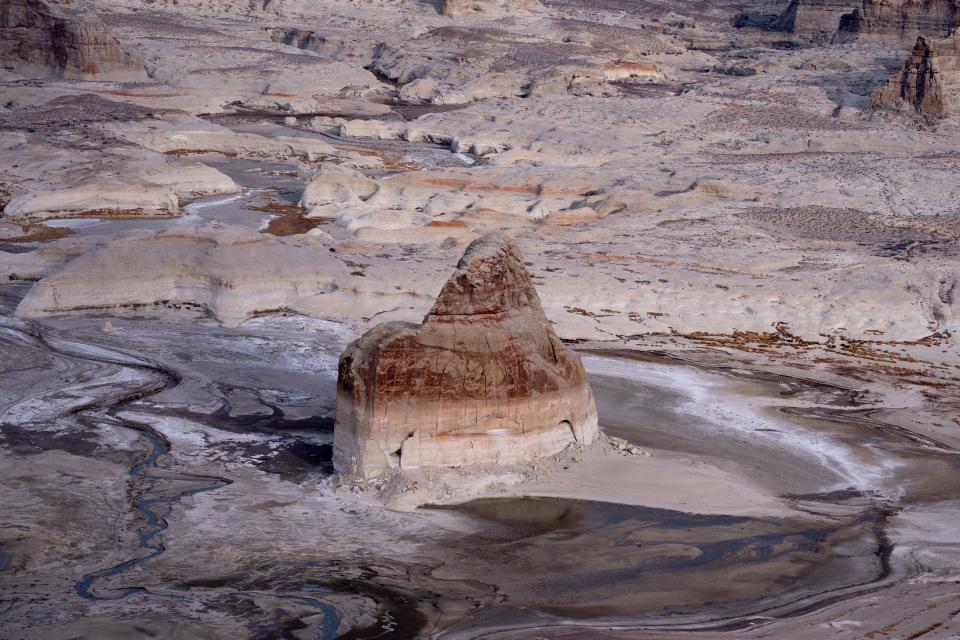A million-acre feet of water won't save Lake Powell. But the deal is still a win
The seven Colorado River basin states have a plan to temporarily stabilize Lake Powell.
It contains some pain and not a lot of gain.
Yet no one balked. And that’s a win.
That should signal how dire the circumstances have become.
The U.S. Department of the Interior noted in an April 8 letter to the basin states that the reservoir is dangerously close to hitting 3,490 feet of elevation, a level so low that power could no longer be generated at Glen Canyon Dam and water could no longer flow to the nearby city of Page and an adjacent Navajo Nation community.
Because water could no longer flow through the power turbines, millions of acre-feet of water would flow downstream through smaller backup pipes at the base of Glen Canyon Dam – a risky prospect that could spell calamity for Lake Mead, which relies on Powell’s releases, if any one of those four pipes were damaged by the heavy flows and had to shut down.
Lake Powell needed immediate action

Interior proposed taking the unprecedented action of withholding 480,000 acre-feet (that’s more than 156 billion gallons) in Lake Powell that otherwise should have flowed to Lake Mead, among other measures.
Two weeks later, the seven states responded with a singular voice: We get how dire this is, and we’re on board.
“We recognize the urgency created by current conditions in the Basin; in fact, hydrologic conditions in the Basin have continued to decline since your April 8, 2022, letter to the Governors’ representatives,” they wrote in an April 22 response. “It is our collective judgment that additional cooperative actions should be taken this spring to reduce the risk of Lake Powell declining below critical elevations.”
That means the upper basin states will agree to release 500,000 acre-feet from the upstream Flaming Gorge Reservoir, as part of a newly cemented 2022 Drought Response Operations Plan. (That’s a lot more than the 161,000 acre-feet that was released from upstream reservoirs last year to prop up Lake Powell.)
Meanwhile, the lower basin states, including Arizona, will agree to keep 480,000 acre-feet in Powell, though the states have asked for that amount not to count against shortage determinations.
What does that mean for shortages at Lake Mead?
The idea, however ill-conceived, is not to use Mead’s actual elevation to determine which shortage tier we’d be in, but rather as if that 480,000 acre-feet were in Mead and not Powell.
It’s not clear how the federal Bureau of Reclamation, which operates the reservoirs, would make that calculation, but the outcome could have real consequences.
The most recent forecast projects elevations as if that 480,000 acre-feet had flowed from Powell to Mead. It puts Mead a few inches above the trigger elevation of 1,045 feet in August, when the following year’s shortage determination is made.
That would put us in a deeper Tier 2 shortage, regardless.
But depending on which side of 1,045 feet we land, we could either fall in a Tier 2a or Tier 2b shortage – which for Arizona is the difference between making previously agreed cuts of 592,000 acre-feet or 640,000 acre-feet.
A Tier 2b shortage also would trigger more stringent water conservation actions in Scottsdale and Tucson. That could mean the imposition of drought surcharges in both cities and, in Scottsdale, the potential for mandatory restrictions.
I know. If we base shortage decisions off where the lake should be, but not really is, we’re making conditions look better than they are. Which doesn’t help us in the long run, even if we could temporarily avoid the pain of Tier 2b.
We extinguished a fire to focus on other work
But, importantly, the states also have agreed that “water year 2023 releases should be carefully monitored and be the subject of consultation with the Basin States to preserve the benefits to Glen Canyon Dam … .”
Translation: Whatever actions we take and shortage levels we set for 2023 will get another look, likely in late winter or early spring, when we have a better idea of the year’s runoff picture, to determine whether we need to do more.
It’s a level of flexibility that we haven’t traditionally had – but will likely need – when lake levels are so low and volatile.
None of this solves anything, of course. Even a combined million acre-feet from the states will likely just prolong the inevitable, hopefully long enough to better assess the strength of Powell’s backup pipes.
And to resume the tough work of storing an extra 500,000 acre-feet each year for the next five years in Lake Mead as part of the 500-plus plan. Without that extra water each year, the lake mostly likely will sink below 1,020 feet of elevation – Mead’s version of the dangerously low level that Powell has already reached.
And – most importantly – to finally sit down and talk about longer-term solutions for the Colorado River, most notably how much water we can reliably expect it to produce. It sure as heck isn’t the 15 million acre-feet that we’ve been apportioned.
Imperfect as this response may be, it’s significant that all seven states agreed to it quickly, so we can get back to the many other pressing tasks at hand.
Reach Allhands at joanna.allhands@arizonarepublic.com. On Twitter: @joannaallhands.
If you love this content (or love to hate it – hey, I won't judge), why not subscribe to get more?
This article originally appeared on Arizona Republic: Lake Powell will get a million-acre feet of water. It's not enough

